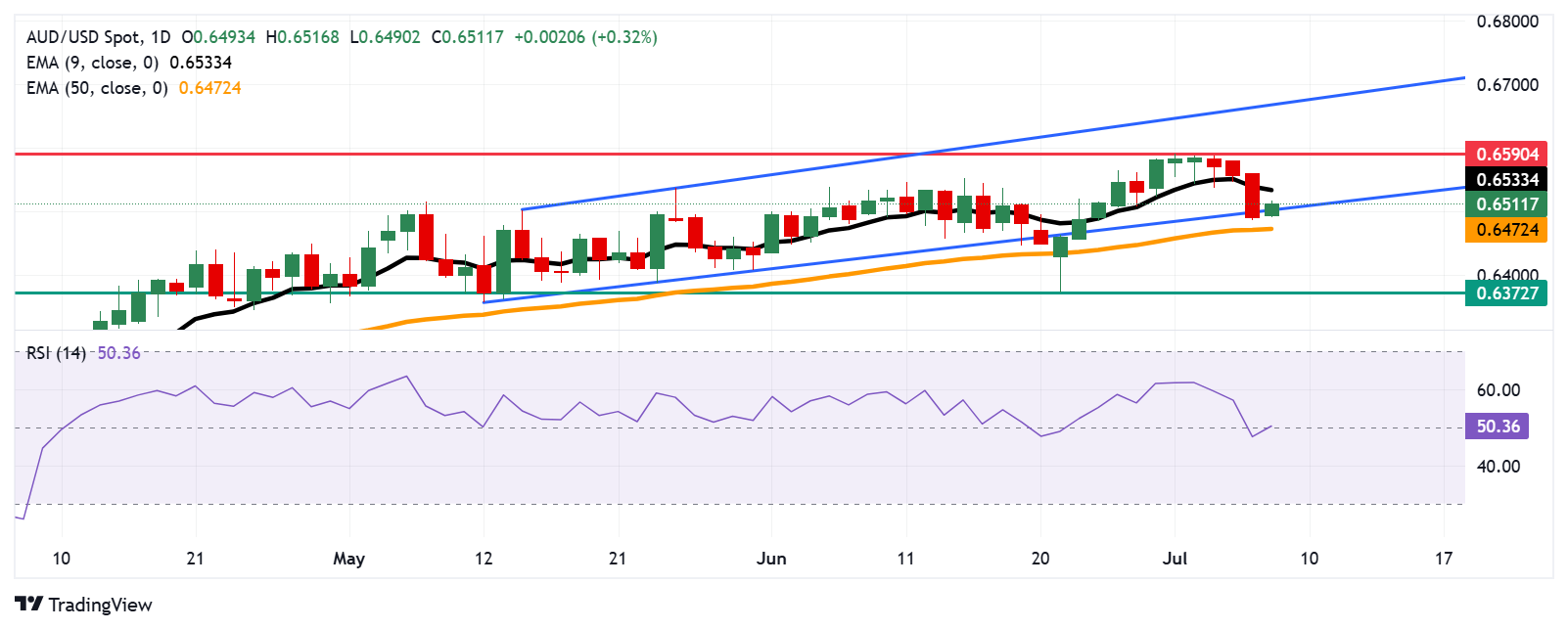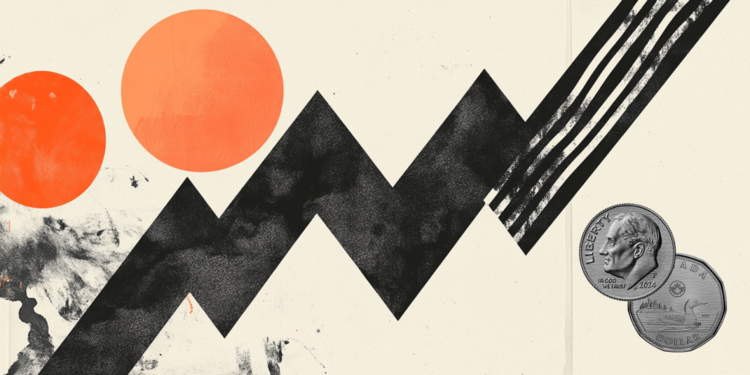- The Australian dollar advances due to the delay in the implementation of Trump tariffs.
- The Bank of the Australian Reserve is expected to deliver a 25 -point basic rate cut on Tuesday.
- President Trump has signed an executive order delaying the implementation of new tariffs from July 1 to August 1.
The Australian dollar (AUD) gains ground against the US dollar (USD) on Tuesday, stopping its three -day loss streak. The Aud/USD pair recorded 1% losses in the previous session in the middle of growing expectations of a rate cut by the Bank of the Australian Reserve (RBA) in July.
The Bank of the Australian Reserve will celebrate a monetary policy meeting on Tuesday at 04:30 GMT and is expected to reduce the official cash rate (OCR) in 25 basic points (PBS) to 3.60% from 3.85%. The operators will also wait for the RBA monetary policy declaration, which will express the opinions of those responsible for policy on current economic conditions, and a perspective that details what they expect for the coming months. Finally, the Governor of the RBA, Michele Bullock, will offer a press conference.
The Aud/Usd pair faced challenges amid renewed concerns about tariffs. However, the White House announced late Monday that US President Donald Trump has signed an executive order delaying the implementation of new tariffs from July 1 to August 1, according to Bloomberg.
Financial Times reported that China is increasingly redirecting its exports through Southeast Asia in an effort to avoid US tariffs imposed by the Trump administration. In May, direct shipments from China to the US fell 43%, while China’s total exports increased 4.8%. This change was marked by a 15% increase in exports to Southeast Asia and a 12% increase towards the European Union (EU). However, the US trade agreement with Vietnam now includes a 40% tariff on traffic goods to stop such practices. Any change in the Chinese economy could impact the AU, since China and Australia are nearby commercial partners.
The Australian dollar advances while the implementation of new US tariffs is delayed
- The US dollar index (DXY), which measures the value of the US dollar compared to six main currencies, remains around 97.50 at the time of writing.
- US President Donald Trump published on social networks on Monday that “any country that aligns with BRICS anti -American policies, an additional 10%tariff will be charged. There will be no exceptions to this policy.”
- Non -agricultural payrolls of the US indicated that the US workforce grew by 147,000 jobs, exceeding 110,000 anticipated in June. In addition, the unemployment rate decreased to 4.1% from 4.2%. Meanwhile, the weekly applications of unemployment subsidy fell to 233,000, from 237,000, reflecting an American resilient labor market.
- The change of US employment from the US fell for the first time in more than two years in June. Private sector payrolls decreased by 33,000 in June after an increase reviewed down 29,000 in May. This figure was below the market consensus of 95,000.
- China’s Ministry of Commerce said in a statement on Friday that “China and the US are intensifying efforts to implement the results of the London framework.” USA has notified China on the cancellation of restrictive measures against Chinese exports. China is reviewing requests for export licenses for controlled articles under laws and regulations.
- The Caixin Services PMI of China fell to 50.6 in June from 51.1 in May, failing in the 51.0 market forecast. The Purchase Managers Index (PMI) Manufacturing Caixin of China improved 50.4 in June from 48.3 in May, according to the latest data published on Tuesday. Reading exceeded 49.0 market forecast.
- Anz’s employment ads increased 1.8% in June after a 1.2% drop in May. The data has the number of employment ads in the main metropolitan newspapers and in the Internet sites in Australia.
The Australian dollar moves above 0.6500, bounces towards the upward channel
The Aud/USD torque is negotiating around 0.6510 on Tuesday. The technical analysis of the daily graphic indicated a renewed bullish feeling, since the pair has bounced towards the existing ascending channel pattern. The 14 -day relative force (RSI) index is positioned at level 50, suggesting a neutral bias. Additional movements will offer a clear directional trend. The pair is maintained below the 9 -day exponential (EMA) mobile average, which suggests that the impulse of short -term prices is weakening.
The Aud/USD torque could try the main barrier in the 9 -day EMA of 0.6533. A rupture above this level could improve the price impulse and support the torque to approach to the maximum of eight months of 0.6590, registered on July 1. Additional advances would support the torque to explore the region around the upper limit of the upward channel around 0.6670.
On the negative side, the AUD/USD torque could prove the lower limit of the upward channel around 0.6500, followed by the 50 -day EMA at 0.6472. A rupture below this crucial support zone would weaken the impulse of medium -term prices and open the doors so that the torque proves the minimum of two months in 0.6372.
AUD/USD: Daily graphic

Australian dollar Price today
The lower table shows the percentage of change of the Australian dollar (AUD) compared to the main currencies today. Australian dollar was the strongest currency against the Japanese yen.
| USD | EUR | GBP | JPY | CAD | Aud | NZD | CHF | |
|---|---|---|---|---|---|---|---|---|
| USD | -0.25% | -0.19% | 0.06% | -0.16% | -0.31% | -0.24% | -0.17% | |
| EUR | 0.25% | 0.07% | 0.33% | 0.10% | -0.08% | 0.02% | 0.08% | |
| GBP | 0.19% | -0.07% | 0.28% | 0.02% | -0.14% | -0.05% | 0.02% | |
| JPY | -0.06% | -0.33% | -0.28% | -0.24% | -0.39% | -0.26% | -0.14% | |
| CAD | 0.16% | -0.10% | -0.02% | 0.24% | -0.18% | -0.08% | -0.01% | |
| Aud | 0.31% | 0.08% | 0.14% | 0.39% | 0.18% | 0.10% | 0.16% | |
| NZD | 0.24% | -0.02% | 0.05% | 0.26% | 0.08% | -0.10% | 0.07% | |
| CHF | 0.17% | -0.08% | -0.02% | 0.14% | 0.01% | -0.16% | -0.07% |
The heat map shows the percentage changes of the main currencies. The base currency is selected from the left column, while the contribution currency is selected in the upper row. For example, if you choose the Australian dollar of the left column and move along the horizontal line to the US dollar, the percentage change shown in the box will represent the Aud (base)/USD (quotation).
Economic indicator
RBA interest rate decision
He Australian Reserve Bank (RBA) announces your decision on interest rates at the end of your eight meetings scheduled per year. If the RBA adopts a hard line posture on the inflationary perspectives of the economy and uploads interest rates, it is usually bullish for the Australian dollar (Aud). Similarly, if the RBA has a moderate vision of the Australian economy and maintains interest rates without changes, or reduces them, it is considered bassist for the AUD.
Read more.
Next publication:
Mar Jul 08, 2025 04:30
Frequency:
Irregular
Dear:
3.6%
Previous:
3.85%
Fountain:
Reserve Bank of Australia
Source: Fx Street
I am Joshua Winder, a senior-level journalist and editor at World Stock Market. I specialize in covering news related to the stock market and economic trends. With more than 8 years of experience in this field, I have become an expert in financial reporting.







